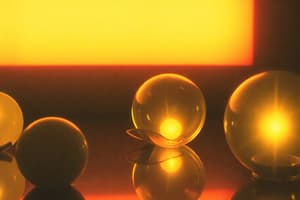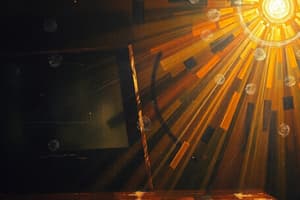Podcast
Questions and Answers
Which of the following is an example of a translucent object?
Which of the following is an example of a translucent object?
- A wooden door
- A frosted glass lampshade (correct)
- A sheet of aluminum foil
- A clear glass window
Which of the following is NOT a characteristic of opaque objects?
Which of the following is NOT a characteristic of opaque objects?
- They block all light from passing through
- They can be seen clearly (correct)
- They can be made from a variety of materials
- They reflect light from an external source
The moon is considered a non-luminous object because it:
The moon is considered a non-luminous object because it:
- Is too far away to be seen clearly
- Reflects light from the sun (correct)
- Is made of rock and dust
- Does not have its own internal light source
A fire is considered a luminous object because it:
A fire is considered a luminous object because it:
Which of the following is an example of a luminous object?
Which of the following is an example of a luminous object?
Flashcards
Luminous Objects
Luminous Objects
Objects that produce and emit their own light.
Non-Luminous Objects
Non-Luminous Objects
Objects that reflect light but do not emit their own.
Transparent Objects
Transparent Objects
Objects that allow full light passage, enabling clear visibility.
Translucent Objects
Translucent Objects
Signup and view all the flashcards
Opaque Objects
Opaque Objects
Signup and view all the flashcards
Study Notes
Luminous and Non-Luminous Objects
- Luminous objects emit their own light
- Examples include: stars, light bulbs, fire, lightning
- Non-luminous objects reflect light from an external source
- Examples include: Moon, planets, buildings, most objects around us
Transparent, Translucent, and Opaque Objects
-
Transparent objects: Light passes completely through them, allowing objects on the other side to be clearly seen
-
Examples: clear glass, clean water, clean air
-
Translucent objects: Light passes through them, but not completely, so objects on the other side are not clearly visible
-
Examples: trace paper, frosted glass, muslin cloth
-
Opaque objects: Light does not pass through them; they block the view of objects on the other side
-
Examples: wood, metal, cardboard
Studying That Suits You
Use AI to generate personalized quizzes and flashcards to suit your learning preferences.




